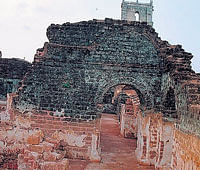Georgia to host Indian archaeologists next month

ASI Director-General K N Shrivastava, superintending archaeologist N Taher, who headed the Old Goa excavation through its crucial phase, and his assistant Abhijit Ambekar are scheduled to travel to Georgia early next month. Taher will also make a presentation of the excavation findings before a distinguished audience of archaeologists and historians at Tbilisi.
The story revolves around a complex interplay of historical factors and the abiding faith of the east European country that relentlessly pursued the recovery of its queen’s relics.
The visit has great significance for the people of Georgia where Queen Ketevan is revered as the patron saint, Taher, now in charge of the ASI in Bhopal, told Deccan Herald. Queen Ketevan’s Goa link goes back to a tragic chapter in Georgia’s history.
Taken prisoner in 1613 when Persian emperor Shah Abbas I ran over the east Georgian kingdom of Khakhety, Ketevan was put to death in Shiraz in 1624 for refusing to convert to Islam from Orthodox Christianity. She rose to sainthood and in 1627, a part of her remains (an arm) was brought to Goa from Persia by two Augustinian friars. Historical accounts record the relics were encased in stone box within a chapel in the enormous Augustinian complex at Old Goa.
When the first official request to uncover the Georgian queen’s remains was made by the then Soviet Union to the Government of India in 1985, the ASI was confronted with a monumental task. All that remained of the 16th century St Augustine complex was a skeletal tower. Mountains of crumbled stone covered a massive area. The excavation ploughed on, yielding the first signs of success in 2005 when the coping stone that held the box with the queen’s remains was unearthed by Taher’s team, though the box itself wasn’t there. The ASI has subsequently excavated human remains.
The excavation has conclusively identified the spot where the saint’s relics were kept, Taher said. Tests done by the Centre for Cellular and Molecular Biology have also established that a long bone found in the ruins is ancient. But without the DNA of the Ketevan lineage to work on, these cannot be scientifically established as the queen’s relics. The ASI has asked the Georgian authorities to trace female descendents of the queen to attempt a final DNA match. Another chapter in the Ketevan mystery is still to unfold.
DH News Service